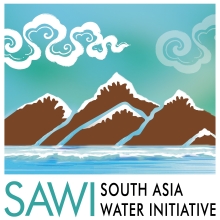The South Asia Water Initiative (SAWI) was a multi-donor trust fund supported by the United Kingdom, Australia, and Norway, and administered by the World Bank. SAWI closed in June 2021 after more than a decade of work to increase regional cooperation in managing major Himalayan river systems and building climate resilience. The World Bank and other trust funds continue to build on SAWI's work, and cross-border water and climate activities can be found on the #OneSouthAsia website.
SAWI supported climate resilience and sustainable, fair, and inclusive development by:
SAWI worked in the Indus, Ganges and Brahmaputra river basins and in the Sundarbans wetlands, shared by Bangladesh and India. Together, SAWI activities spanned seven countries: Afghanistan, Bangladesh, Bhutan, China, India, Nepal and Pakistan.

Indus Basin
The Indus Basin is one of the most vulnerable river basins with complex water challenges, glacier dependency, and growing per capita water scarcity.
SAWI focused on activities where client demand was clear. One focus was providing technical assistance at the national level to enhance transboundary (including inter-provincial boundaries) water resources management capacity. A second SAWI focus was supporting the Indus Basin dialogue that began in 2013 to promote cooperation, and developing joint research on climate change impacts by basin stakeholders.
Ganges Basin
SAWI worked to improve Ganges River basin management and resilience to climate change. Technical dialogues for stakeholders in the basin sought to increase trust through information exchanges and capacity building. For example, in India, improvements in data sharing between the central government and the states is a necessary precursor to broader public and international transparency.
SAWI supported clean-up of the Ganges to improve flows for river health, cross-sectoral water allocation, and inland navigation. Work also included the design and implementation of the World Bank-financed National Hydrology Project in India.
SAWI helped improve flood forecasting in the Baghmati sub-basin and strengthened Bihar and Nepal cooperation in flood management. In Nepal, SAWI supported river basin and hydropower planning with related watershed management for sediment control.
Brahmaputra Basin
SAWI activities addressed flooding and riverbank erosion, and assessed economic opportunities such as hydroelectric power and inland navigation. SAWI sponsored knowledge exchanges, study tours, workshops, and assessments to help stakeholder countries build a case for regional cooperation that leads to economic benefits.
SAWI helped develop a knowledge base to support Brahmaputra basin investment planning. Work included modeling, decision-making tools for policymakers, and capacity building activities in government agencies to operationalize the tools. SAWI's adaptive management framework helped build community resilience to water and climate risks and invested in early warning systems and flood mitigation measures. The Brahmaputra dialogue provided a platform for stakeholders to discuss common challenges, build trust, and promote collaboration.
Sundarbans
The Sundarbans is the world's largest delta where the Ganges, Brahmaputra, and Meghna rivers come together and spill into the Bay of Bengal. The fragile wetlands is shared by Bangladesh and India and faces challenges that include extreme poverty, frequent natural disasters, and salinization of drinking water. The Sundarbans would benefit if both countries agreed on a joint conservation and development policy, and worked together on programs.
SAWI supported work to implement bilateral agreements for collaboration on international waters, information sharing, disaster management, and climate change adaptation. SAWI developed a strong foundation of research about the Sundarbans environment and its impact on human health to help governments move toward integrated management.
Blogs and feature stories about our Sundarbans work:
Increasing salinity in a changing climate likely to alter Sundarban’s ecosystem
Climate change drives up river salinity in Bangladesh
When cyclones strike: Using mangroves to protect coastal areas
Protection from cyclones: Benefits of integrating green and gray infrastructure
Bangladesh: Can mangroves mitigate catastrophic consequences of cyclone-induced storm surges?
Will availability of fish decline in Sundarbans with climate change? (in Bengali language)
May our children always have fish and rice (in Bengali language)
The Bangladesh India Sundarban Region Cooperation Initiative (BISRCI), supported by the World Bank, created a web site with news and information generated by EnGIO and The Third Pole.
Regional
In addition to activities in the three major river basins and the Sundarbans, SAWI did regional cross-cutting work to build knowledge, capacity, and transboundary basin dialogue and cooperation.
SAWI's strategy was to improve the quality and accessibility of regional water resources datasets. The program also built knowledge and capacity for shared water management, and to support broad-based regional dialogue to build trust and enhance transboundary waters cooperation in South Asia.
SAWI-funded Knowledge Products
The South Asia Water Initiative (SAWI) funded technical assistance and analytical work to enhance transboundary water management, support dialogue to build trust among stakeholders, and inform related World Bank investments. Reports, briefs, and other products funded by SAWI are listed below.
Indus River Basin
Ganges River Basin
Brahmaputra River Basin
Sundarbans
Groundwater Management
Flood Risks
Regional Work
Related research (the following work paved the way for SAWI-funded research about the Sundarbans and was supported by the Knowledge for Change trust fund and the Bangladesh Climate Change Resilience Fund)